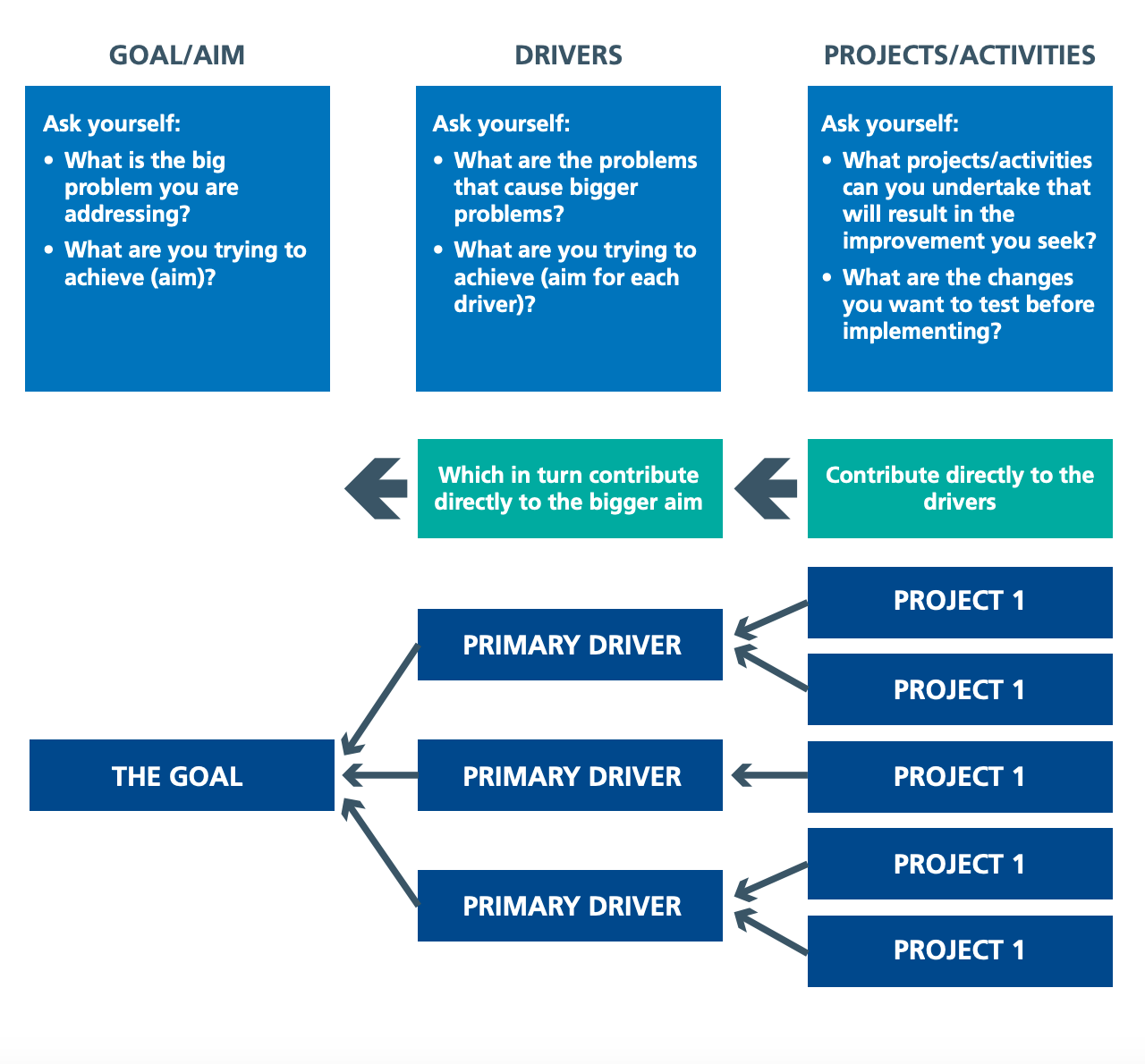Start improving with Life QI today
Full access to all Life QI features and a support team excited to help you. Quality improvement has never been easier.

Organisation already using Life QI?
Sign-up

In this set of articles, we’re going to focus on driver diagrams: what a driver diagram is used for, when driver diagrams are used and how you can use a driver diagram for quality improvement (QI) in your setting.
Let’s start by looking at the definition of a driver diagram. Described by the Institute for Healthcare Improvement (IHI) as a ‘visual display of a team’s theory of what drives or contributes to, the achievement of a project aim’, driver diagrams are a great way of demonstrating to people exactly what an improvement team is testing or working on.
Dr Don Goldmann at IHI describes a driver diagram as a ‘simple, visual, somewhat intuitive display to help you understand where you’re going with your work.’ Essentially, driver diagrams are really useful for communicating to a range of stakeholders a QI team’s shared view and direction of travel.
Also known as a tree diagram, the driver diagram: ‘helps an individual or team to understand and plan their organisation’s improvement aim, translating it into a set of visible drivers and changes that underpin it’.
The ‘drivers’ referred to in ‘driver diagram’ offer a straightforward way of demonstrating how certain changes may or may not affect the improvement aim. While they also offer the team a representation of key actions that may need to be taken in order to progress.
You might want to take a look at this really helpful video. Don Goldmann at IHI explains the driver diagram looking at its value and how it can help you and your team to progress in your QI work.
The key thing to remember is that if you are able to demonstrate your QI theory via your driver diagram, you will be able to keep your stakeholders engaged.
It’s really useful to create your driver diagram early on in the planning stages of your QI project and it can then be added to as the project progresses.
The NHS England and NHS Improvement ‘Online library of Quality, Service Improvement and Redesign tools’ report on driver diagrams talks about the structure, thus: ‘Driver diagrams are structured charts of three or more levels. They translate a high level improvement goal/aim into a logical set of high level factors (primary drivers) that you need to influence in order to achieve your goal. They also show the specific projects/activities that would act on these high level factors.’
Let’s take a closer look at what makes up a driver diagram, starting with the ‘Aim’.
The ‘Aim’ or the ‘improvement aim’ really sits at the heart of the driver diagram. It's vital for your driver diagram and starts the process off, providing a focal point for the project and a measurable goal. It’s best if this vital component of the driver diagram follows the SMART acronym, i.e. Specific, Measurable, Achievable, Relevant and Time-bound, in order to support your QI work.
The National Institute for Children's Health Quality (NICHQ) describe the Aim statement as a ‘clear, explicit summary of what your team hopes to achieve over a specific amount of time including the magnitude of change you will achieve. The aim statement guides your work by establishing what success looks like.’ While the IHI describes an aim statement as ‘the answer to the first question in the Model for Improvement, ‘What are we trying to accomplish?’
Research has shown that teams who create a good aim perform better, so it’s really important to get it right! You might want to read in more detail about how to create an Aim statement.
Once you have created your ‘aim’ you can then start to look at your primary and secondary drivers and change ideas which will help you bring about change.
Primary drivers are the ‘bigger’ ideas that will help you bring about change in your QI project. They are another important element – and indeed an underpinning goal - of the driver diagram.
The NHS England and NHS Improvement ‘Online library of Quality, Service Improvement and Redesign tools’ report on driver diagrams says: ‘The overall goal is linked to factors or sub-goals that are believed to have a direct impact on it. The first set of underpinning goals are referred to as primary drivers because they ‘drive’ the achievement of your main goal. These drivers may act independently or in combination to achieve the overall goal/aim’
Essentially, you are breaking down a goal in order to create drivers. So, for example, the primary driver can be broken down into sub goals, and indeed, secondary drivers.
Secondary drivers are useful for when you want to break down your primary drivers even further. They are a strong influence on your primary drivers – and need to be even more specific. For secondary drivers, you will need to write these carefully as these will help you further identify relevant change ideas. As your driver diagram is ultimately helping you to define the change initiatives that you want to carry out, secondary drivers are important to help you influence your primary drivers.
Although the NHS England and NHS Improvement ‘Online library of Quality, Service Improvement and Redesign tools’ report on driver diagrams highlights that there are no prescribed number of primary and secondary drivers or actions that should be included, it does state that what is important, however, is that ‘the diagram clearly shows the causal relationships between the projects, hierarchy of drivers and aim.’
Change ideas are those easy to implement and smaller initiatives which mean that your QI project is able to move from planning to implementation. In essence, these are what you need to identify and test to enable you to achieve your goal.
When you are writing down your change ideas to include in your driver diagram, it’s worth bearing in mind that each change idea should have an effect on at least one of the secondary or primary drivers – these will all help you to achieve your aim.
It might be an idea to prioritise and rank your change ideas by impact and effort. This can be a really useful group activity and can be carried out by reflecting on which of the change ideas would have the most impact on the ‘Aim’.
The team at NHS England and NHS Improvement Online library of Quality, Service Improvement and Redesign tools report on driver diagrams state that : ‘the ultimate aim of a driver diagram is to define the range of projects (ie actual change initiatives) that you want to undertake. These can appear anywhere in the hierarchy of the driver diagram – wherever makes most sense.’
We’re now going to look at where the driver diagram fits in the QI journey in quality improvement. The creation of a driver diagram creation is most useful if it is developed at an early stage of the project – in fact the earlier in the process the better. The driver diagram can then be updated during the QI journey when and where required. This process means that the QI team can become more engaged throughout the process and can regularly contribute to different levels of change ideas and drivers throughout the project life cycle.
For all these steps within your driver diagram to take place, it helps to have an IT solution that works to support you create your driver diagram. A solution like Life QI can help you build your driver diagram and, in turn, visualise your theory for improving the quality of care. You can take your project aim and also set out those contributing factors and changes that will help you to realise that aim. Teams at East London Foundation Trust use Life QI to build their driver diagrams in quality improvement with great success.
There are some really good hints and tips here on how to use driver diagrams in quality improvement. Or you could also read our article about driver diagrams.
To finish with the words of the NHS England and NHS Improvement Online library of Quality, Service Improvement and Redesign tools report on driver diagrams ‘When you are dealing with complex change it is often difficult to differentiate between cause and effect and it is rare to be able to attribute a particular outcome to one particular change you have made. Driver diagrams can be used to show your theories of cause and effect in your system – in other words, your theories about what changes will likely cause the desired effects and achievement of your aim. It is helpful to create driver diagrams.’

Figure 1: Driver diagram showing goal/aim, drivers and projects/activities (Source)
Full access to all Life QI features and a support team excited to help you. Quality improvement has never been easier.

Organisation already using Life QI?
Sign-up